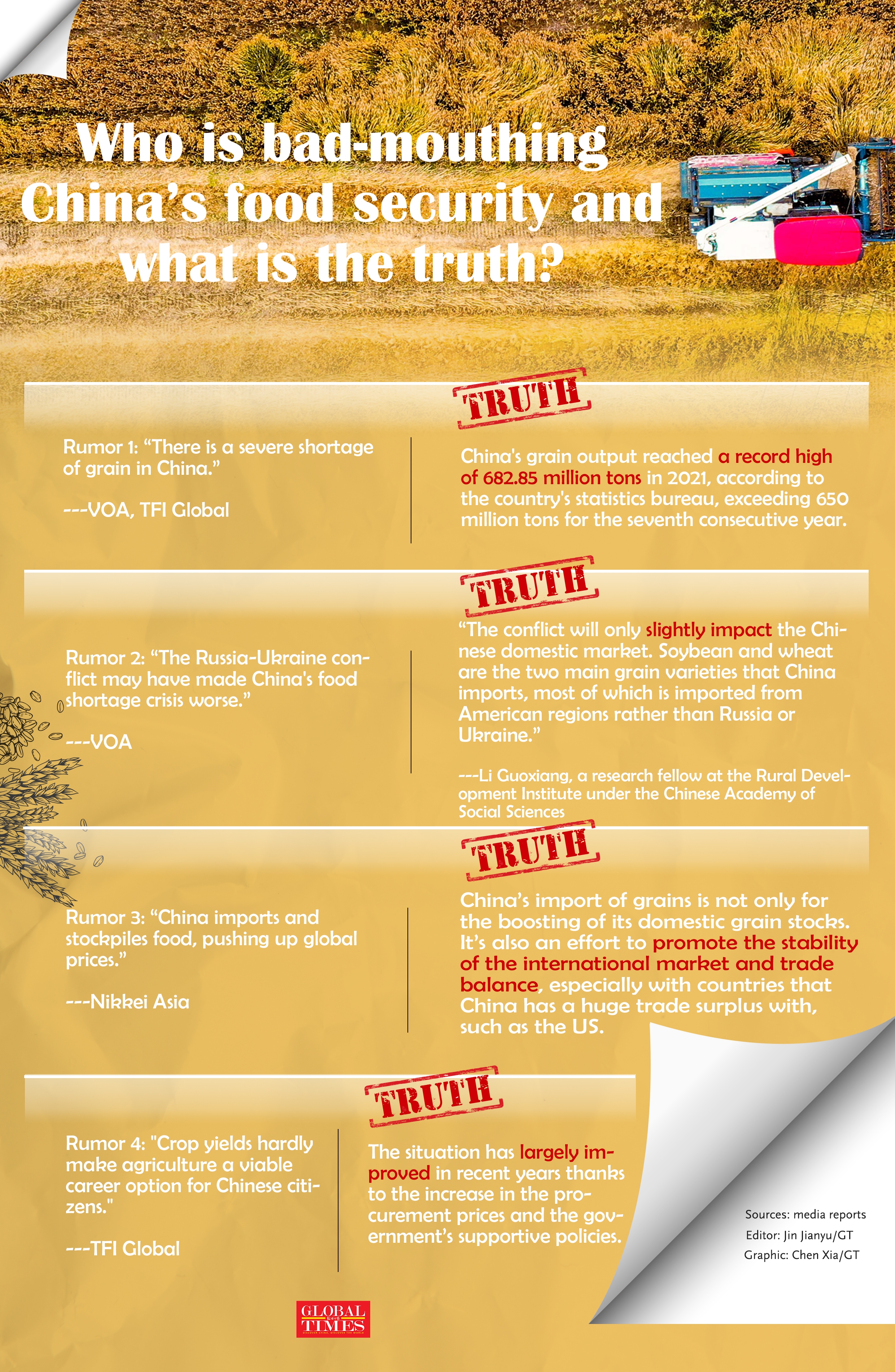[ad_1]
As a region with a population of somewhere around 1.4 billion, China attaches great great importance to meals security.
The conflict among Russia and Ukraine has pushed up foodstuff and fertilizer selling prices, and some impacts on international grain provides have been witnessed. However China has certain its foods protection, some overseas media stores took this option to falsely claim that China will face grain shortages, to stoke panic and blame China for the rigidity in Ukraine.
Who is hyping China’s intended food stuff concern? Are China’s grain manufacturing and provides safe sufficient? How will China guarantee its foodstuff supply?
The World Times will existing a few investigative reports in the coming days. This is the initially installment.

Wheat harvest in Yuncheng, North China’s Shanxi Province in June 2020 Photo: VCG
Meals safety has develop into a new matter utilised by some Western media stores to smear China, as the conflict amongst Russia and Ukraine has, to some degree, brought about a grain price tag raise and challenged grain materials globally.
Such narratives as presented by these media outlets on China’s food source safety declare China faces “extreme scarcity in meals,” “increasing imports of grains,” and even “poisonous soil” and “recurrent pure disasters,” drawing a conclusion that China’s food provide is seriously insecure.
On the other hand, upon nearer inspection, it is not really hard to uncover that these statements are baseless. In addition, the media shops producing these arguments are some “familiar faces,” who frequently smear China on several other issues and stay on it.
Professionals pointed out that these types of smear methods are “in accordance with the US’ efforts to extend the Western countries’ hostility towards Russia to China.”
Minister of Agriculture and Rural Affairs Tang Renjian claimed in early March throughout the two sessions that, at existing, China’s overall grain source is plentiful, and the for each capita grain possession is 483 kilograms, an improve of 9 kilograms more than 2021’s 474 kilograms.
“No issue how the intercontinental scenario adjustments, we have the capability to assure that far more than 1.4 billion people today have foods on time every single working day with no starving, and they will try to eat far better and far better,” he noted.
Developing crises devoid of a foundation
In a latest report, VOA claimed on March 16 that the Russia-Ukraine conflict has pushed up world-wide rates of wheat and other commodities, which it mentioned may well worsen China’s food stuff scarcity.
TFI World-wide, owned by anti-China Indian media group The Discouraged Indian (TFI), explained alone as “the very first news team from about the entire world to tell you that China was reeling below an powerful foods disaster,” and attributed the “food crisis” to China’s “toxic soil” and “regular organic disasters.”
“No person needs to be a farmer in China… Returns are small and crop yields rarely make agriculture a practical vocation selection for Chinese citizens. In addition, individuals from rural China are migrating to city centers in look for of much better livelihoods,” TFI Worldwide asserted.
CNN, nonetheless, linked the alleged food shortages to China’s rigorous COVID-19 containment actions, declaring that rigid avoidance and management of the epidemic has led to a larger cost of food items and disrupted food supplies.
Observers pointed out that some foreign media businesses have even long gone to the extent of fabricating knowledge about the alleged foodstuff lack.
Japan-based Nikkei Asia, for instance, claimed that in buy to reduce the meals crisis, China is importing massive amounts of meals and hoarding it, pushing up international selling prices and even producing famine in some nations. TFI even declared that China is “top the campaign in setting up this hegemonic food stuff disparity.”
CNN concluded that China’s foodstuff disaster has sparked nervousness and distrust of the government in China, centered on a November 2021 observe from China’s Ministry of Commerce which prompt households to stockpile a sure total of necessities. Some media outlets asserted the Chinese government’s endeavor to head off issues about pricing and provide seems to be “spiraling out of manage.”
The Russia-Ukraine conflict has inadvertently amplified foods selling prices in the international industry, but that will only have a slight impression on the Chinese domestic industry, mentioned Li Guoxiang, a analysis fellow at the Rural Development Institute below the Chinese Academy of Social Sciences. “Soybean and wheat are two principal foodstuff crops that China imports, most of which are imported from American locations instead of Russia or Ukraine,” Li informed the Worldwide Occasions.
Li explained that China truly has no shortage of wheat as a foodstuff staple. The many sorts of wheat it imports are for diversified and unique uses, this kind of as building bread and steamed buns. “It really is a natural result of the improvement of our people’s living specifications.”
Palm oil, which accounts for just about 50 percent of all humanly-consumable oil China imports, is also from Southeast Asia. Imported soybeans, many of which are also for cooking oil extraction, are largely from American nations around the world together with the US and Brazil, Li included.
The rise in costs of agricultural provides such as fertilizers in the Chinese marketplace, which some Western media retailers highlighted in recent days, is not only brought about by fluctuations in the intercontinental industry, but also by China’s voluntary reduction of fertilizer creation, mentioned rice pro Li Ganghua, a professor at the Faculty of Agriculture underneath Nanjing Agricultural College (NAU).
“China has taken the initiative to slash down fertilizer creation for the sake of environmental security and emission reduction,” Li Ganghua explained to the World wide Times. Aside from importing fertilizer (to lessen its sector price), China is also producing specialized improvements to switch specified raw resources with much more eco-pleasant kinds, he included.
Experts attained by the Global Periods also refuted TFI’s assertion that “no a single in China desires to be a farmer.”
Rising grain could not have been worthwhile in China in the past, but the predicament has mainly enhanced in the final pair of decades due to the maximize in the procurement value, and the government’s supportive policies, Li Guoxiang said.
“For case in point, farmers in Northeast China informed me that planting corn can deliver them 1,700 to 1,800 yuan ($267-283) for every mu, and the planting price tag is only 400 to 500 yuan for every mu,” Li Guoxiang recalled. “They said now they scramble to expanding grain.”

Youngsters have lunch at a kindergarten in Shangluo, Northwest China’s Shaanxi Province. Picture: VCG
Improper targets
These media outlets basically used any topic they could discover to smear China or buzz the “China menace” idea as they have a deep-rooted prejudice and hostility toward China, Liu Weidong, a exploration fellow at the Institute of American Scientific tests at the Chinese Academy of Social Sciences, told the Global Moments.
They would interpret something about China from a damaging perspective no matter no matter whether China has finished it or not, and no make any difference how much-fetched the “evidence” is, Liu stated.
China’s import of grains is not only for supplementing its domestic consumption, said Li Guoxiang. It truly is also an exertion by China to endorse the steadiness of the intercontinental market place and encourage a trade stability, particularly with the countries with which China has a enormous trade surplus, this sort of as the US, he mentioned.
“China can make an hard work to very well employ the bilateral relations,” Li Guoxiang advised the World Moments. “But unfortunately, they [the US-led West] always have a lot to say on that – when we import extra grains, they say we have a foods protection disaster when we purchase fewer, they say we advocate for trade protectionism.”
In a VOA report on March 16, an “skilled” from Taiwan island claimed there were being reviews on Chinese social media platforms by the end of 2021, which stated that some regional governments on the Chinese mainland were encouraging inhabitants to hoard meals. The “professional” claimed that in retrospect, that move “maybe implies that China understood that Russia would start a war on Ukraine as early as 2021 and started to inquire people to hoard food items in situation of a food crisis adhering to the war.”
These types of speech is plainly intended to give voice to a conspiracy principle that China had been educated in advance and acquiesced to Russia’s navy motion in Ukraine. Such declare is in accordance with the US’ attempts to blame China for the Russia-Ukraine conflict and develop the Western countries hostility from Russia to China, in accordance to Liu.
Even so, analysts pointed out that it is the West, and in particular the US, that should be principally held liable for the Russia-Ukraine conflict, which has escalated to a large humanitarian crisis, which include a world wide food disaster.
Armenia, Mongolia, Kazakhstan, and Eritrea import just about all of their wheat from Russia and Ukraine and need to now locate new resources. But they are competing against a lot bigger customers, like Turkey, Egypt, Bangladesh, and Iran, which source far more than 60 per cent of their wheat from Russia and Ukraine, The New York Times reported.
Nooruddin Zaker Ahmadi, director of the Bashir Navid Elaborate, an Afghan imports business, told The New York Periods that “the United States thinks it has only sanctioned Russia and its banking companies, but the United States has sanctioned the whole globe.”

Harvest in Daye, Central China’s Hubei Province in Oct 2021. Picture: VCG
Is China genuinely going through a food items crisis?
There is no will need to be overly worried about “food crisis,” which is in fact nonexistent in China, agriculture students and business insiders told the International Periods.
Li Guoxiang estimates that China’s grain cultivation locations will increase to some 1.8 billion mu by the end of this 12 months from the 1.76 billion mu in 2021, many thanks to favorable procurement prices and the government’s supportive policies.”
China’s grain output reached a report substantial of 682.85 million tons in 2021, in accordance to the country’s stats bureau, exceeding 650 million tons for the seventh consecutive yr, according to the “No.1 central document.”
In 2019, China’s for every capita grain yield achieved about 470 kilograms, much higher than the intercontinental food items stability typical of 400 kilograms for every man or woman, in accordance to yicai.com
Governmental policies have also inspired insurance policies for food safety. China unveiled a grasp program for the modernization of the agricultural sector and rural places by way of 2025, as the governing administration ratcheted up steps to guarantee meals safety, enable farmers bolster incomes, and consolidate the results of its poverty reduction campaign, in accordance to the Chinese federal government.
Globally, the conflict amongst Russia and Ukraine will undoubtedly lead to grain offer complications, mentioned Li Guoxiang. Whilst the conflict would not largely have an impact on the Chinese domestic industry at existing, he explained that China can attempt its very best in made up of the doable hazard.
“What we can do is enhance cultivation locations, these types of as expanding soybean cultivation places in Northeast China, and further more make improvements to the enthusiasm of our grain farmers, like boosting the procurement selling price of rice,” he advised.
Moreover, China is also assisting other international locations bolster their food stuff materials. The region decided to provide 2,000 tons of rice as crisis food items support to Sri Lanka, explained the Chinese embassy on March 26.

Who is lousy-mouthing China’s food security and what is the reality? Infographic: Chen Xia/GT
[ad_2]
Supply connection






